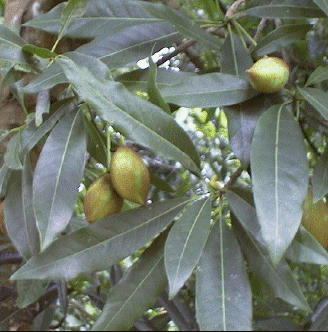MAHUA

Botanical name : Madhuca latifolia
Family : Sapotaceae
Distribution
The tree grows throughout the greater part of India except the temperate and arid areas and southern parts of the India peninsula. It is a common tree of the deciduous forests of Madhya Pradesh, Maharashtra, Gujarat, Central India, Indian peninsula, Chota Nagpur, Orissa and is characteristic of dry plains. It is extensively cultivated near villages because of its multi utility, Two varieties, viz., var. longifolia and var. latiflolia are recognized. The former grows in South India and the latter in North India.
Environmental requirement
Climate and Temperature
It is a tree of dry tropical and subtropical climate. In its natural habitat, the absolute maximum shade temperature varies from about 410C to 480C, the absolute minimum temperature from about 10C to 80C.
Rainfall
The normal annual rainfall from about 750 to 1875 mm. The man relative humidity in its natural range varies from about 40 to 80% in January and from about 60 to 90% in July.
Soil
The tree grows on a wide variety of soils, but prefers sandy soils. It grows well in alluvial soils of the Indo-Gangetic plains. In Sal forests, it is found growing on high clay and even calcareous soils.
Phenology
Flowering takes place during March-April. Fleshy corolla falls off before or with the appearance of new leaves. About 10 year old trees start flowering. One to two good seed years may be expected every three years.
Silvicultural Characters
It is a strong light demander and get suppressed under shade. The trees coppices well if felled in hot season. It has better taproot system.
Climate and Soil
It is a tree of dry tropical and subtropical climate. In its natural habitat, the absolute maximum shade temperature varies from about 410C to 480C, the absolute minimum temperature from about 10C to 80C and the normal annual rainfall from about 750 to 1875 mm. The man relative humidity in its natural range varies from about 40 to 80% in January and from about 60 to 90% in July.
The tree grows on a wide variety of soils, but prefers sandy soils. It grows well in alluvial soils of the Indo-Gangetic plains. In Sal forests, it is found growing on high clay and even calcareous soils.
Nursery Techniques
Ripe fruits are collected by shaking the branches. Fruits are rubbed and washed to obtain clean seeds. About 450 seeds weigh one kg. Fresh seeds have sigh germination capacity, which however is soon lost on storage. Fungi and insects readily attach the seeds.
Fresh seeds are sown at a depth of about 1.5 to 2.5 cm. One-month-old seedlings are transplanted in nursery beds. Late transplanting gives poor results. Spacing in transplant beds is 30 x 15 cm; shading the seedling is necessary, One-year-old seedlings are used for planting in main field. Seedlings can also be containerized. In that case, one-month-old seedlings are pricked into containers. Shading is necessary.
Planting
Planting is one in 30 cm3 pits at a spacing of 4x 4 m. Planting of stumps is done in crow bar holes or 30 cm3 pits
Utilization
Leaves are used as fodder. Flowers and fruits can also be fed to cattle. Leaves contain crude protein 9.8%, crude fibre 20.3%; N free extract 60.7%; ether extract 4.1%; total ash 7.8%, calcium 1.6%, phosphorus 0.2%. Seeds contain 39% oil which is used for cooking and soap making. Seed cake is also fed to cattle. It also makes a good manure. It contains (on dry matter basis), the flowing : crude protein 19.4%, ether extract 12.0%; crude fibre 62.2%, total ash 6.4%; calcium 0.2%, phosphorus 0.8%; digestible crude protein-8.0% total digestible nutrients 60%. Flower can also be fed to livestock to replace cereal concentrates. A fully developed tree can produce upto 90 kg of flowers in a year. The chemical composition (in per cent) of the flowers is crude protein 8.0; ether extract 1.4;crude fibre 30.4; N free extract 52.4; total carbohydrate 83.8; total ash 7.8; calcium 0.22; phosphorus 0.16. The protein content is comparable to that of rice and the total carbohydrate to that of maize and oats as also the availability of total digestible nutrients. Flowers are used by the tribals as a source of alcohol. |

